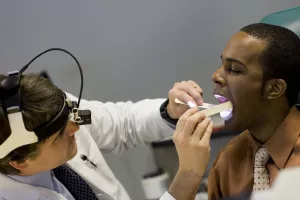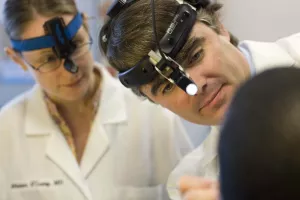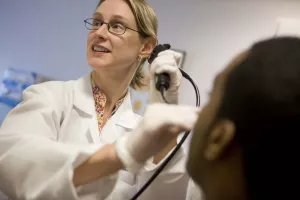We understand the value of sleep and the impact it can have on your health. That’s why we're excited to offer an implantable therapy called upper airway stimulation (UAS). UAS is designed to treat obstructive sleep apnea (OSA) and help you rediscover your sweetest dreams.
Rest is assured with upper airway stimulation
Approximately 18 million Americans — 1 in 15 adults — have OSA.
The most common treatment for sleep apnea is called continuous positive airway pressure (CPAP), a device that steadily blows air at a higher pressure than normal to help push soft tissues aside while you sleep. But CPAP masks can feel uncomfortable and clunky, and its steady hum can disrupt light sleepers.
Upper Airway Stimulation (UAS) is a treatment avoids the typical problems that CPAP devices can present, so you only have to concentrate on getting a good night’s sleep.

Conditions
Obstructive sleep apnea (OSA) which frequently occurs as a result of the tongue falling back in the throat during sleep, blocking the airway and preventing oxygen from going to the blood. When this occurs, for some, hundreds of times per night, the brain wakes up the body to take a breath. This resulting poor quality of sleep can have negative health effects including:
Testing
The main symptom of sleep apnea is hard to miss: loud snoring. But there are plenty of symptoms to watch for. If you or your partner check yes to the following questions, it may be time to seek help from our sleep specialists.
- Do you have trouble falling asleep?
- Do you stop breathing for a few seconds in your sleep, suddenly choking or gasping for air?
- Are you tired even after a full night’s rest?
- Do you fall asleep at odd times — in meetings, in class, on the train — and feel fatigued all day?
How to qualify for UAS
You may be a good candidate for Inspire UAS if you:
- Are at least 22 years of age
- Have been diagnosed with moderate to severe obstructive sleep apnea
- Meet certain weight requirements
- Struggle to get a consistent benefit from CPAP
If you meet all the eligibility requirements, your doctor will need to confirm that you have moderate-to-severe OSA. From there, this is what the process will look like:
- If you have not had a recent sleep study, you may need to have a new one.
- Afterward, your doctor will assess your airway anatomy through a simple procedure under light sedation.
- After your assessments are complete, your doctor will work with your insurance company to sort out your coverage.
- Once insurance coverage is confirmed, your surgery will be scheduled.
Treatments
How does UAS work?
While you’re sleeping, the Inspire UAS system monitors every breath you take. Based on your unique breathing patterns, the system delivers mild stimulation to the hypoglossal nerve, which controls the movement of your tongue and other key airway muscles. When these muscles are stimulated, the airway remains open during sleep.
What are the benefits of UAS treatment?
Some benefits of UAS include:
- Better quality sleep
- Improved quality of life
- Less snoring
- Lower risk of heart- and brain-related side effects
- More alertness during the day
Inspire UAS has been found to be incredibly successful. In a study of 126 OSA patients, patients experienced a 78% reduction in sleep apnea events per hour at their three-year follow-up. And 85% of bed partners reported no snoring or soft snoring from their bed partner using UAS therapy at their four-year follow-up.
What to expect
You’ll go home the same day as your procedure, and there’s no need to change your diet ahead of time. Your UAS device will be implanted while you’re in a deep sleep under general anesthesia.
Recovery is much quicker and less painful than other surgical procedures for OSA, but you may feel discomfort at the small incision sites following the surgery. This can be managed with over-the-counter pain medication.
The Inspire UAS implant will become activated one month after surgery. We’ll ask that you visit us for a routine sleep study about 4-6 weeks after activation to optimize your implant settings. Once the device is implanted, you’ll have it for life. A simple swap-out procedure to replace the battery will happen every 10 years or so.

From regular office visits to inpatient stays, find the healthcare you need and deserve close to home.

Meet the doctors and care team devoted to supporting you every step of the way along your path to better health.